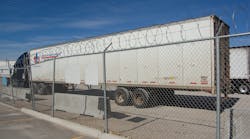Cargo thieves are beginning to more frequently target freight during the holidays as increased volumes combined with more demanding delivery times and tight capacity often results in a “relaxation” of theft prevention protocols.
“It’s because of those higher volumes relative to holiday demand that often leads to skipping over the basic cargo security checks,” Don Hsieh, director of commercial and industrial marketing for Tyco Integrated Security, explained to Fleet Owner.
“But it’s the basic ‘blocking and tackling’ by front-line employees – drivers and dockworkers – that deters cargo thieves,” he stressed. “Good basic protocols like checking driver identifications, paperwork, and cargo [container] seals. It’s following those procedures consistently that really helps deter cargo thieves.”
Consulting firm FreightWatch International noted that the last four months of the calendar year have become a “prime time” of sorts for cargo thieves, particularly due to how heightened supply and demand factors impact transportation operations.
“Limitations on available carr“This pressure often results in security practices being overlooked or sometimes avoided altogether,” FreightWatch said.
Thus, by continuing to observing logistics security fundamentals, participants throughout the supply chain can minimize their chances of falling victim to cargo thieves, it noted.
For example, one growing problem is the “deceptive criminal” posing as a legitimate carrier – picking up a load and then disappearing with it. Tyco’s Hsieh said that following basic protocols such as the aforementioned checks on driver identification and paperwork can help reduce such instances.
Another “fundamental” where trucking is concerned is never stopping in what FreightWatch dubs the “Red Zone,” defined as the first 200 miles from the shipment’s origin. “Historically, a vast majority of cargo theft occurs within the first 200 miles of transport,” the firm noted.
Tyco’s Hsieh explained that the one of the big reasons the Red Zone poses higher risk is that cargo thieves now typically monitor freight facilities more closely so they can target specific loads.
“Don’t think you are not being watched; thieves are always watching,” he cautioned. “That’s why your front-line personnel are your best deterrents. They know who their co-workers are so can readily spot unknown people. Being observant and asking questions are critical: this is still a human business.”
To avoid exposure to the Red Zone, FreightWatch believes carriers and shippers alike should ensure drivers preparing to depart under load have enough logbook hours for at least four hours of driving, with tractors containing enough fuel to safely traverse the Red Zone before stopping.
“Emergency stops within a Red Zone should be carefully monitored with constant communication with the driver strictly enforced,” the firm added.
“Lastly, unattended staging for any length of time in the Red Zone should be avoided at all costs,” FreightWatch said. “Should it be the only option, drivers should park in a well-lit, secured area with the trailer backed to a permanent fixture or natural obstacle, and employ sound technology such as brake locks, fuel cut-offs, and covert GPS tracking with active monitoring.”
Tyco’s Hsieh stressed, however, that technology cannot solve cargo theft issues if basic protocols are ignored. “None of it helps if you leave a tractor-trailer idling in a truck stop parking lot within the Red Zone,” he said. “That’s why the holidays are a good time to go back and re-stress the importance of following basic procedures.”




